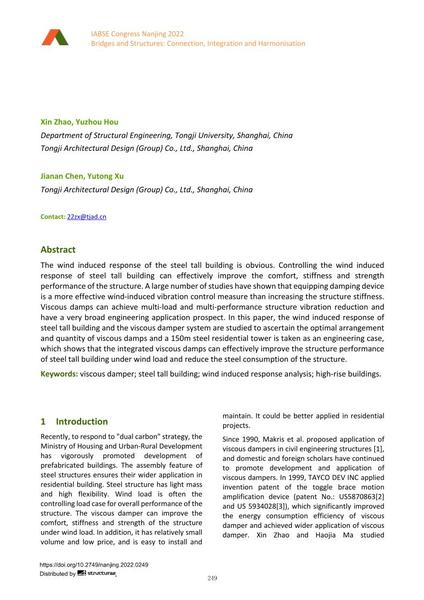Wind Induced Response Analysis and Vibration Mitigation Design for Steel Tall Buildings Equipped with Viscous Dampers

|
|
|||||||||||
Bibliografische Angaben
| Autor(en): |
Xin Zhao
(Department of Structural Engineering, Tongji University, Shanghai, China Tongji Architectural Design (Group) Co., Ltd., Shanghai, China)
Yuzhou Hou (Department of Structural Engineering, Tongji University, Shanghai, China Tongji Architectural Design (Group) Co., Ltd., Shanghai, China) Jianan Chen (Tongji Architectural Design (Group) Co., Ltd., Shanghai, China) Yutong Xu (Tongji Architectural Design (Group) Co., Ltd., Shanghai, China) |
||||
|---|---|---|---|---|---|
| Medium: | Tagungsbeitrag | ||||
| Sprache(n): | Englisch | ||||
| Tagung: | IABSE Congress: Bridges and Structures: Connection, Integration and Harmonisation, Nanjing, People's Republic of China, 21-23 September 2022 | ||||
| Veröffentlicht in: | IABSE Congress Nanjing 2022 | ||||
|
|||||
| Seite(n): | 249-257 | ||||
| Anzahl der Seiten (im PDF): | 9 | ||||
| DOI: | 10.2749/nanjing.2022.0249 | ||||
| Abstrakt: |
The wind induced response of the steel tall building is obvious. Controlling the wind induced response of steel tall building can effectively improve the comfort, stiffness and strength performance of the structure. A large number of studies have shown that equipping damping device is a more effective wind-induced vibration control measure than increasing the structure stiffness. Viscous damps can achieve multi-load and multi-performance structure vibration reduction and have a very broad engineering application prospect. In this paper, the wind induced response of steel tall building and the viscous damper system are studied to ascertain the optimal arrangement and quantity of viscous damps and a 150m steel residential tower is taken as an engineering case, which shows that the integrated viscous damps can effectively improve the structure performance of steel tall building under wind load and reduce the steel consumption of the structure. |
||||
| Stichwörter: |
Hochhäuser
|
||||
| Copyright: | © 2022 International Association for Bridge and Structural Engineering (IABSE) | ||||
| Lizenz: | Die Urheberrechte (Copyright) für dieses Werk sind rechtlich geschützt. Es darf nicht ohne die Zustimmung des Autors/der Autorin oder Rechteinhabers/-in weiter benutzt werden. |
||||
